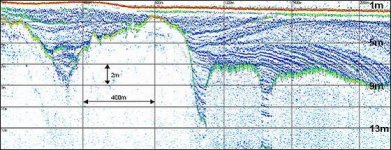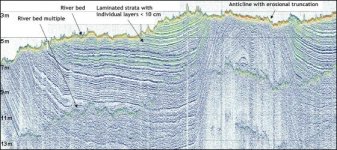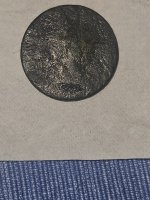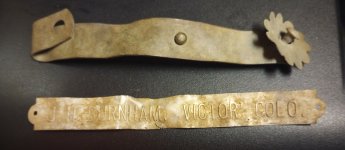Bum Luck
Silver Member
- May 24, 2008
- 3,482
- 1,282
- Detector(s) used
- Teknetics T2SE, GARRETT GTI 2500, Garrett Infinium
- Primary Interest:
- All Treasure Hunting
Interesting looking stuff:
SES-2000 parametric sub-bottom profilers offer advantages at all water depths, but a unique feature is the possibility to work in extremely shallow waters as shown below. Sub-bottom profiling in very shallow water using a pinger, boomer, chirp or seismics is difficult due to reverberation and beam pattern issues (e.g. beam width and sidelobes). On the other hand working in areas with very shallow water is required for a wide variaty of applications like
Using one of Innomar's shallow water SBP models (SES-2000 compact, SES-2000 light, SES-2000 standard) it is possible to get excellent sub-bottom data at water depths down to
less than 0.5 metre

SES-2000 compact parametric SBP echoprint data example from an extremely shallow river in Gambia
(water depth 1–2m; range 1–15m below sea level; sediment penetration more than 10m; frequency 10kHz; pulse width 0.2ms).

SES-2000 standard parametric sub-bottom profiler echoprint data example from a river cable route survey
(water depth 3–7m; range 2–14m below sea level; frequency 8kHz pulse width 0.13ms)
I've always thought that shallows were the biggest salvage challenge.
SES-2000 parametric sub-bottom profilers offer advantages at all water depths, but a unique feature is the possibility to work in extremely shallow waters as shown below. Sub-bottom profiling in very shallow water using a pinger, boomer, chirp or seismics is difficult due to reverberation and beam pattern issues (e.g. beam width and sidelobes). On the other hand working in areas with very shallow water is required for a wide variaty of applications like
- surveys in rivers and harbours
- surveys in coastal areas
- sediment investigation vor dredging projects
- pipeline and cable route surveys
- location and monitoring of buried pipelines and cables
- underwater archaeology
Using one of Innomar's shallow water SBP models (SES-2000 compact, SES-2000 light, SES-2000 standard) it is possible to get excellent sub-bottom data at water depths down to
less than 0.5 metre

SES-2000 compact parametric SBP echoprint data example from an extremely shallow river in Gambia
(water depth 1–2m; range 1–15m below sea level; sediment penetration more than 10m; frequency 10kHz; pulse width 0.2ms).

SES-2000 standard parametric sub-bottom profiler echoprint data example from a river cable route survey
(water depth 3–7m; range 2–14m below sea level; frequency 8kHz pulse width 0.13ms)
I've always thought that shallows were the biggest salvage challenge.





